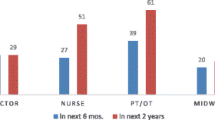Abstract
This study examines health status, health behaviors, and health care access and utilization among African-born residents of the metropolitan Washington, DC area. A telephone survey was administered to a random sample of 525 African-born adults. Results are compared to those for the general local and regional population. Twenty-nine percent of respondents were uninsured; 24% lacked a usual, appropriate source of primary care. Among female respondents, 44% and 34% reported never having had a mammogram or pap smear, respectively. Most health status indicators demonstrated relatively good health, but 15% of respondents reported one of the infectious diseases we investigated. Consumption of alcohol and tobacco was relatively low. African-born residents are generally at risk regarding access to health care, and certain segments (the uninsured, recent arrivals) face critical access barriers. Infectious diseases are a notable feature of health status, and use of some preventive and dental services is considerably lower than for the general population.
Similar content being viewed by others
REFERENCES
Office of Refugee Resettlement: Report to the Congress FY 1996. Refugee Resettlement Program, Administration for Children and Families,U.S. Department of Health and Human Services. Washington, DC: U.S. Government Printing Office 1998–615–032/63142; 1998
Thamer M, Richard C, Casebeer AW, Ray NF: Health insurance coverage among foreign-born US residents. Am J Publ Health 1997; 87(1):96–102
Leclere FB, Jensen L, Biddlecom AE: Health care utilization, family context, and adaptation among immigrants to the United States. J Health Soc Behav 1994; 35(4):370–384
Institute of Medicine: From Generation to Generation: The Health and Well-Being of Children in Immigrant Families. Washington, DC: National Academy Press; 1998
Liu Z, Shilkret KL, Tranotti J, Freund CG, Finelli L: Distinct trends in tuberculosis morbidity among foreign-born and USborn persons in New Jersey, 1986 through 1995. Am J Publ Health 1998; 88(7):1064–1067
McKenna MT, McCray E, Onorato I: The epidemiology of tuberculosis among foreign-born persons in the United States, 1986 to 1993. N Engl Med 1995; 332(16):1071–1076
Centers for Disease Control and Prevention: Screening for hepatitis B virus infection among refugees arriving in the United States, 1979–1991. MMWR Morb Mortal Wkly Rep 1991; 40(45):784–785
Gavagan T, Brodyaga L: Medical care for immigrants and refugees. Am Fam Physician 1998; 57(5):1061–1068
Centers for Disease Control and Prevention: Behavioral Risk Factor Surveillance System Questionnaire. Washington, DC: Centers for Disease Control and Prevention; 1997
National Center for Health Statistics: National Health Interview Survey Redesign, Phase 3: Adult Core and Family Core, June 2, 1997. Washington, DC: Centers for Disease Control and Prevention, USDHHS; 1997
Behavioral Risk Factor Survey of Vietnamese—California 1991: MMWR Morb Mortal Wkly Rep 1992; 41(5):69–72
National Technical Information Service: Immigrants Admitted in the United States, 1990–96 (CD-ROM). Washington, DC: U.S. Immigration and Naturalization Service; 1998
Aday LA: Designing and Conducting Health Surveys. San Francisco: Jossey-Bass; 1996
Centers for Disease Control and Prevention: Behavioral Risk Factor Surveillance System Online Prevalence Data for Virginia, 1997. Washington DC: Centers for Disease Control and Prevention (Web Site); 1999
Hansen LA, Faber CS: The Foreign-Born Population: 1996. Current Population Reports.Washington, DC: U.S. Bureau of the Census; 1997
Newacheck PW, Stoddard JJ, Hughes DC, Pearl M: Health insurance and access to primary care for children. N Engl J Med 1998; 338(8):513–519
Pollick HF, Rice AJ, Echenberg D: Dental health of recent immigrant children in the newcomer schools, San Francisco. Am J Publ Health 1987; 77(6):731–732
Singh GK, Yu SM: Adverse pregnancy outcomes: Differences between US-and foreign-born women in major US racial and ethnic groups. Am J Publ Health 1996; 86(6): 837–843
Chen J, Ng E, Wilkins R: The health of Canada's immigrants in 1994–95. Health Reports; 1996.
Board on Children and Families: Immigrant children and their families: Issues for research and policy. Future Child Crit Issues Child Youth 1995; 5(2):72–89
American Academy of Pediatrics: Policy Statement: Health care for children of immigrant families. Pediatrics 1997; 100(1):153–156
Emanuel B, Aronson N, Shulman S: Malaria in children in Chicago. Pediatrics 1993; 92(1):83–85
Ku L, Matani S: Left out: Immigrants' access to health care and insurances. Health Affairs 2001; 20(1):247–256
Author information
Authors and Affiliations
Corresponding author
Rights and permissions
About this article
Cite this article
Siegel, J.E., Horan, S.A. & Teferra, T. Health and Health Care Status of African-Born Residents of Metropolitan Washington, DC. Journal of Immigrant Health 3, 213–224 (2001). https://doi.org/10.1023/A:1012231712455
Issue Date:
DOI: https://doi.org/10.1023/A:1012231712455




